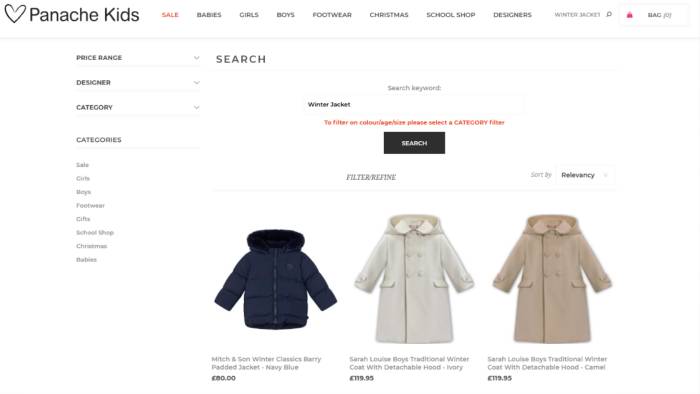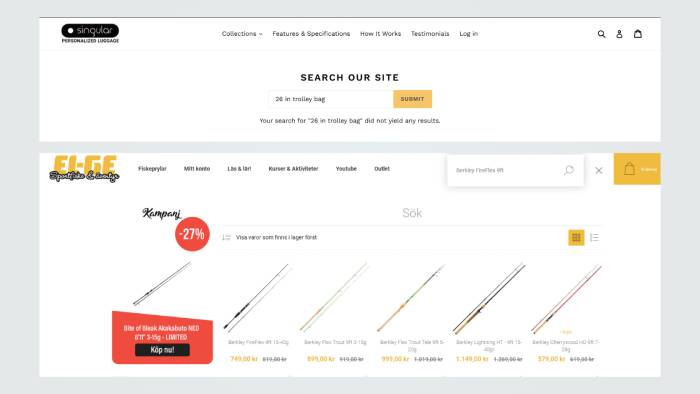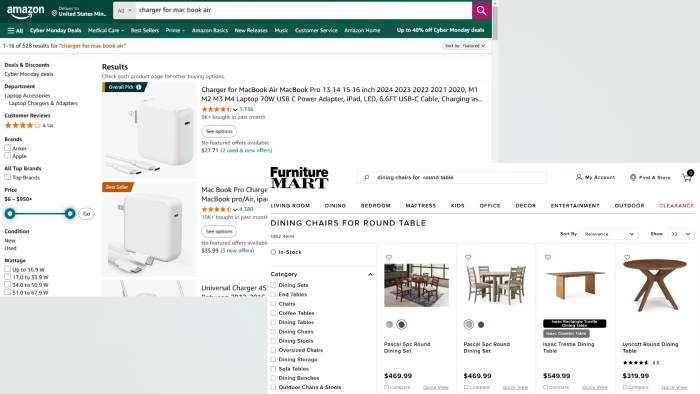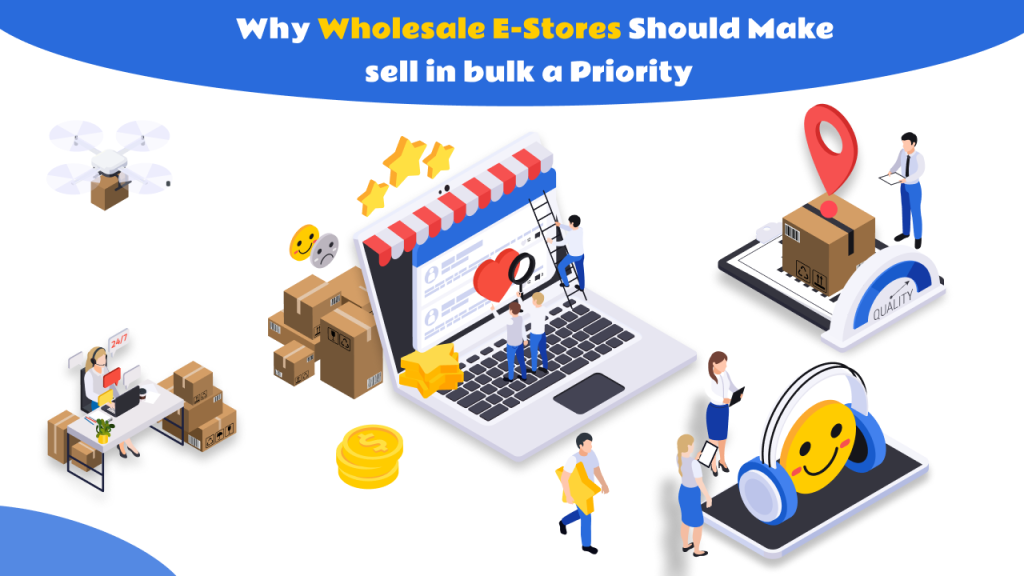Exploring the 8 Essential E-commerce Search Query Types
From E-commerce UX to Revenue: Exploring the 8 Essential E-commerce Search Query Types
Let’s face it—search is the heart of any e-commerce site. In today’s competitive online marketplace, having a smart, efficient search functionality isn’t just a nice-to-have; it’s what makes or breaks the customer experience. In our previous blog, we discussed how 41% of e-commerce sites are still getting their search wrong, leading to missed revenue and frustrated customers. Whether users are searching for specific products or browsing product categories, they expect seamless, fast, and relevant search results.
We talked about the 8 essential e-commerce search queries that form the backbone of a successful online store’s search experience. Now, it’s time to dive deeper into all those e-commerce search query types to understand their importance, the common pitfalls sites face, and how you can optimize them to ensure a smooth and satisfying customer journey.
1. Exact Searches: Precision and Purchase Intent
Exact searches occur when users know exactly what they want. These searches typically involve specific product names, models, or SKUs (e.g., “iPhone 14 Pro” or “STH2000DM004”). The intent here is clear: the user is already well-informed and looking for the exact product and is more likely to make a purchase when it is found.
Why It Matters: Users conducting exact searches are highly valuable because they are often at the final stage of their purchasing journey. They’ve done their research and are now ready to buy. If your site fails to return precise results for these searches, you risk losing a sale to a competitor who can deliver what the customer is looking for.
Common Pitfalls:
- Inconsistent Product Listings: If product names, SKUs, or attributes are not consistent across the site, users may not find the exact product they’re searching for.
- Lack of Full-Text Search: If your e-commerce search engine is not supporting full-text search like Amazon or Google offers, then most likely products are not found when the product name or SKU code doesn’t match exactly the search query.
- Improper use of Tokenizers: Without proper tokenization of your product contents and search query, the exact search may likely fail resulting in “no product found”.
- No Auto complete or Search Suggestions: Without search suggestions, users may type the exact product name but misspell it slightly, leading to zero results.
Let’s see if I can search my model number… Yes, there it is—so good!” This participant appreciated being able to search by SKU (model number) on hoober.com.Providing SKU-based search ensures users can quickly find the exact model they’re looking for, enhancing their overall shopping experience.
Optimizing Exact Searches:
- Maintain Accurate and Standardized Product Data: Ensure that SKUs, product names, and models are consistent and up-to-date across all listings, and are tagged appropriately.
- Implement Full-Text Search: Make sure to implement full-text search for your e-commerce store using dedicated search platforms like Apache Solr, Elastic Search, or Algolia, which supports advanced text analysis and helps you improve your search results. Look for a full-text search plugin for the platform you’re using to find something that is readily available.
- Understand and Implement Tokenizers as per your need: Not all stores are equal. Similarly, find what your visitors are searching for and optimize how you use tokenizers to support various formatting, synonyms, stop words, etc. You can also implement phonetic tokenization to improve it more.
- Implement Auto complete: Help users by providing relevant search suggestions as they type, guiding them quickly to the exact product they seek.
- Implement Search Suggestion: You could also use the spell check feature of the search platform you’re using that helps you offer relevant search suggestions in case of misspelled search queries.
- Prioritize Exact Matches in Search Results: Ensure that exact matches appear at the top of the results to prevent users from having to scroll through irrelevant products.
Let’s search with mobile model name… Yes, it shows the result! When users search with the (full text query) exact model name, they get accurate results. The tokenization and search features work seamlessly on amazon.com, making it easy for users to quickly find the same product they’re looking for.
2. Product Type Searches: Simplifying the Browsing Process
Product type searches involve users searching by a general product category, such as “women’s sneakers” or “laptops.” These users may not have a specific product in mind but are exploring a range of options.
Why It Matters: Product-type searches are often the starting point for users who are still in the decision-making process. Relevant search results that are offered in a well-organized and easily navigable way help guide users to the right products quickly, building trust and encouraging exploration.
Common Pitfalls:
- Overwhelming Search Results: Presenting too many irrelevant or loosely related products can overwhelm users and discourage further exploration.
- Lack of Clear Product Categories: If your categories are not clearly defined or logically organized, users will struggle to find the products they are interested in.
- Clear, Intuitive Product Categorization: Organize your products into straightforward categories with intuitive navigation paths to make searching simple and effective.
- Effective Filtering Options: Allow users to refine their product searches based on various attributes such as brand, price, color, and size. Such multi-faceted filters make product type searches manageable and tailored to user needs so they can find products faster. Most search platforms offer options to implement such multi-faceted filters out of the box.
Optimizing Product Type Searches:
Etsy Website has advance search features, like “Product Type Search” make exploring easier. For example, if someone’s browsing laptops without a specific choice in mind, helpful filters guide them to options they’ll love—boosting chances of a purchase.
3. Feature Searches: Targeting Product Attributes
Feature searches occur when users look for products with specific attributes or characteristics, such as “waterproof jacket” or “Bluetooth headphones.” They know the product type but want a specific feature.
Why It Matters: Supporting feature searches ensures that users with specific needs can find the products that match their criteria. If users can’t filter or search by the features they want, they’re likely to leave the site and look elsewhere.
Common Pitfalls:
- Limited Attribute-Based Filters: Not offering sufficient filters for key product features can lead to frustration when users can’t narrow down results.
- Irrelevant Search Results: If the search algorithm doesn’t prioritize products based on the requested feature, users may be presented with irrelevant results, leading to abandonment.
- Comprehensive Filtering Options: Ensure that feature-related filters (e.g., waterproof, wireless, eco-friendly) are available and easily accessible on search result pages.
- Feature-Rich Search Indexing: Make sure your search engine indexes product features properly, so users searching for specific attributes find accurate results.
- Display Feature Highlights: Show key product features prominently in search results to help users quickly identify the items that match their needs.
Optimizing Feature Searches:
Panache Kids website offers an intuitive search experience with “feature-based queries” and advanced filter options. Visitors can easily select specific categories and attributes, ensuring their search queries deliver relevant results tailored to their needs.
4. Use Case Searches: Matching Products to User Intent
Use case searches happen when users are looking for a product to fulfill a specific need or occasion, such as “travel backpack” or “birthday gift for mom.” These users are focused on the context in which they’ll use the product.
Why It Matters: Use case searches are highly contextual, allowing you to tap into user intent directly. If you can serve results that match these scenarios, you’ll increase the likelihood of engagement and conversion, as users feel you understand their needs.
Common Pitfalls:
- Misaligned Product Suggestions: When search results don’t match the intended use case, users may feel disconnected from your offerings.
- Limited Focus on Contextual Queries: If your site doesn’t consider different use cases, it may fail to cater to a wide range of customer needs.
Websites like H&M, which sell clothing, are among the most popular brands. However, when searching with a use case like ‘Birthday Dress for Mom,’ their search functionality often fails. On the other hand, websites like alwaysfashion.com provide relevant results, showcasing the effectiveness of their search functionality. These websites utilize readily available plugins to ensure visitors get accurate and relevant results.
Optimizing Use Case Searches:
- Curated Recommendations: Use personalization or curated lists to present products that match specific use cases (e.g., “top travel gear” or “gifts for moms”).
- Tailored Content for Occasions: Consider building occasion-based content on category pages (e.g., “best backpacks for travelers”). Ensure to index this content for searches, making it easy for users to find products tailored to their needs.
- User Intent Recognition: Ensure your search engine recognizes the intent behind queries and delivers results that align with those specific contexts.
5. Abbreviation/Symbol Searches – Catering to Modern Search Behavior
Abbreviation and symbol searches occur when users input shortened forms or symbols instead of full product names (e.g., “26 in trolley bag” instead of “26 inch trolley bag”). As mobile shopping continues to grow, users prefer these shorter inputs to save time and effort.
Why It Matters: In the dynamic world of e-commerce, efficiency is what customers prioritize most. When users search with abbreviations or symbols, they expect results that match their intent quickly. If your search engine cannot interpret these abbreviated terms correctly, users will see irrelevant results or, worse, nothing at all. This frustration can drive them away, possibly to a competitor’s site.
One online store selling bags and luggage fails to support search terms with abbreviations like “in” for “inch,” causing searches to fail and visitors to leave without purchasing. In contrast, other websites effectively handle abbreviations like “ft” for “feet,” ensuring a smoother search experience and better user retention.
Common Pitfalls:
- Lack of Abbreviation Recognition: Many e-commerce sites fail to map common abbreviations (e.g., “in” for inch) to the full terms, resulting in missed opportunities to connect users with the right products.
- Limited Flexibility in Search Algorithms: If your search engine doesn’t accommodate the variations in user inputs, such as symbols or shorthand, you risk returning irrelevant or no results.
Optimizing for Abbreviation/Symbol Searches:
- Develop a Comprehensive Dictionary of Abbreviations: Ensure your search system recognizes common abbreviations and symbols used by customers. For example, map “cm” to “centimeter” and “kg” to “kilogram” so that users find relevant results regardless of how they input their queries.
- Implement Dynamic Auto-Suggest: As users begin typing, provide real-time search suggestions that include both full terms and their abbreviated versions. This not only guides users quickly but also reinforces your search engine’s flexibility.
- Regularly Update and Test Search Capabilities: Monitor search logs to identify any new abbreviations or shorthand that users commonly use. Continuously refine your search algorithm to incorporate these patterns, ensuring the search experience remains intuitive and responsive.
As this store supports abbreviations and symbols while also offering “multi-faceted filters” options, visitors can easily refine their searches. Filters like price, hair type, gender, and brands make it simple for users to find exactly what they’re looking for, improving their overall shopping experience.
By accommodating abbreviation and symbol searches, you create a more user-friendly search experience that aligns with modern browsing behavior, particularly on mobile devices.
6. Compatibility Searches – Helping Users Find Compatible Products
Compatibility searches are when users look for products that work together, such as “charger for Mac Book Air” or “case for iPhone 14 Pro.” These searches often occur when users are trying to find accessories or add-on for products they already own.
Why They Matter: Customers who conduct compatibility searches are often highly intent-driven, seeking to complete their purchase with additional products. This presents a prime opportunity for cross-selling and up-selling compatible items, boosting overall sales and customer satisfaction.
Common Pitfalls:
- Insufficient Product Linking: If your site doesn’t effectively link related or compatible products, users may struggle to find the accessories or additional items they need.
- Limited Filtering Options: Without filters that allow users to refine their search based on compatibility criteria, such as brand or model type, users may face difficulties narrowing down their options.
Amazon continues to lead the way with its smart compatibility searches. Take thefurnituremart website, for example. Sure, they show results, but are they really relevant? Let’s say a visitor searches for ‘Dining chairs for a round table.’ The website should understand that the user likely already owns a round table and is now searching for matching accessories or add-ons.
Optimizing for Compatibility Searches:
- Cross-Link Products in Descriptions: Ensure that product pages include detailed compatibility information and cross-links to accessories or related items. For example, if a user views a laptop, they should see suggestions for compatible chargers, cases, and peripherals directly on the product page.
- Develop Compatibility Filters: Add filters that enable users to specify compatibility criteria such as “works with Mac Book Air” or “fits iPhone 14 Pro.” These filters streamline the search process, it’s all about helping users find the right product without any trouble.
- Personalize Product Recommendations: Use customer browsing data to suggest compatible products based on their past purchases or current searches. For example, if a user has previously bought a phone, show them cases or accessories compatible with that model.
By optimizing for compatibility searches, you not only help customers find what they need efficiently but also create opportunities for increasing average order value through effective cross-selling strategies.
7. Symptom Searches – Providing Solutions, Not Just Products
Symptom searches occur when users look for solutions to specific problems rather than searching for a product by name (e.g., “remedy for dry skin” or “cure for headaches”). These users often describe a need or symptom they want to address, seeking guidance and relevant product options.
Why They Matter: Symptom searches are highly solution-oriented. When users search for solutions rather than products, they are likely in need of assistance and may not know exactly which product suits their needs. Meeting these customers’ needs builds trust and credibility, positioning your brand as a problem solver and increasing the likelihood of conversion.
Common Pitfalls:
- Inadequate Mapping of Symptoms to Solutions: If your search engine doesn’t recognize symptom-based queries, you miss the opportunity to present relevant solutions.
- Limited Educational Content: Without supportive content (e.g., guides or articles) accompanying product listings, you may miss the chance to engage users and build trust.
Optimizing for Symptom Searches:
- Integrate Products with Content: Tag relevant products with educational content that addresses common symptoms. For example, include blog posts or guides on how to manage dry skin, accompanied by recommended moisturizers or skin care products.
- Create a Symptom-Based Index: Train your search system to recognize and respond to symptom-related queries. By mapping terms like “back pain relief” to ergonomic chairs or back supports, you can match users with the products they need.
- Build Symptom-Specific Landing Pages: Develop dedicated pages that target common symptoms or needs (e.g., “Solutions for Dry Skin”). These pages can house related products, customer reviews, and expert tips, making it easy for users to find solutions in one place.

Both websites sell skincare products, but found that only one supports ‘Symptom Searches.’ What does that mean? It means that having a visually appealing layout and great design isn’t enough to succeed in e-commerce. When users don’t get relevant search results, you fail as an online seller.
Supporting symptom searches effectively can transform your site into a trusted resource, encouraging users to return and explore more products.
8. Non-Product Searches – Addressing User Questions Beyond Products
Non-product searches involve users seeking information about your site’s policies, services, or other details unrelated to specific products (e.g., “return policy,” “gift wrapping options,” or “shipping information”).
Why They Matter: Non-product searches are crucial for building customer trust. Customers often look for reassurance before making a purchase, and if they can easily find answers to their questions, they are more likely to proceed with their order. Supporting these queries also shows transparency, which can improve brand loyalty.
Common Pitfalls:
- Inadequate Informational Pages: If users cannot find clear, detailed information about your site’s services or policies, they may become frustrated and leave.
- Poor Indexing of Non-Product Content: Focusing search algorithms solely on products without indexing FAQ and policy pages can lead to missed search results when users look for non-product information.

Searching for “return policy” on Amazon yields “Returns Center” links, along with a short description of the return policy and a set of links to relevant Help sections. On molu.com, a search for “return policy” directs users to the relevant result, where numerous return-related FAQs are available.
Optimizing for Non-Product Searches:
- Build a Comprehensive FAQ Section: Ensure that all common questions related to policies, shipping, and services are answered in a well-organized FAQ section. This makes information readily accessible and improves user satisfaction.
- Index Policy Pages and Guides in Your Search Engine: Include these non-product pages in your search index so that users can access relevant information directly through the search bar.
- Offer Quick Links and Search Shortcuts: Incorporate shortcuts or quick links within the search bar that direct users to key information like “Returns” or “Shipping Information,” ensuring users find answers quickly.
By optimizing for non-product searches, you not only enhance the user experience but also build trust and reduce potential friction points in the buying process.
Conclusion:
By mastering all eight e-commerce search query types— Exact Searches, Product Type Searches, Feature Searches, Use Case Searches, Abbreviation/Symbol Searches, Compatibility Searches, Symptom Searches, and Non-Product Searches—you ensure your site caters to diverse user needs and intent. Each query type plays a crucial role in the customer journey, from helping users find specific products to solving their problems or answering their questions.
An optimized search experience not only enhances user satisfaction but also drives conversion rates, customer retention, and overall revenue growth. When your search engine delivers fast, accurate, and relevant results, it builds trust and loyalty, encouraging users to return for future purchases.
Stay tuned for more insights and practical strategies to enhance your e-commerce business. Your customers’ search experience is your gateway to revenue—make it exceptional!

































